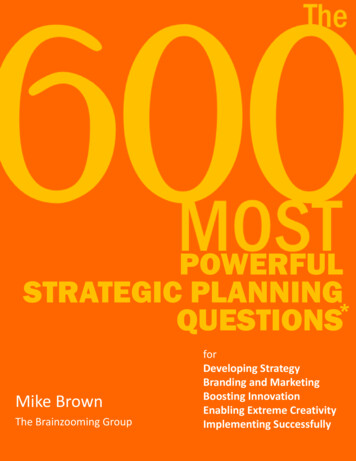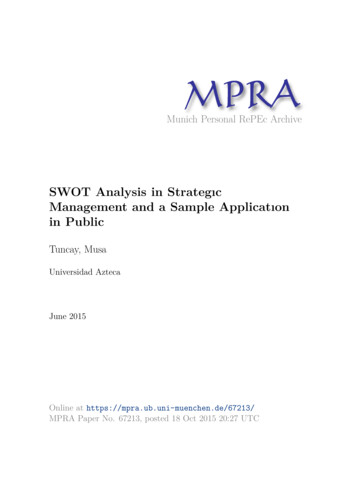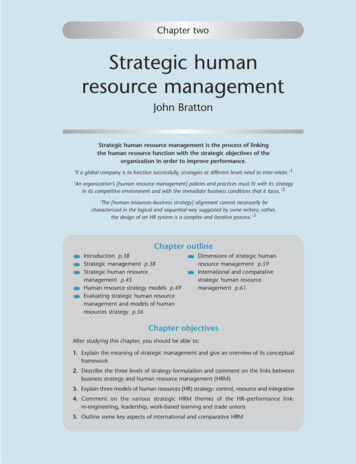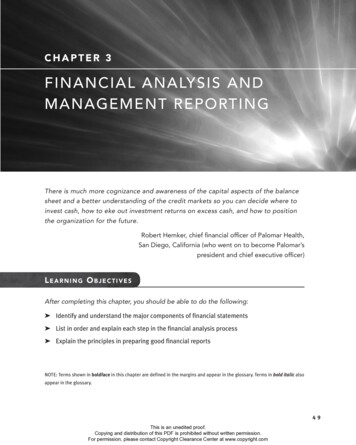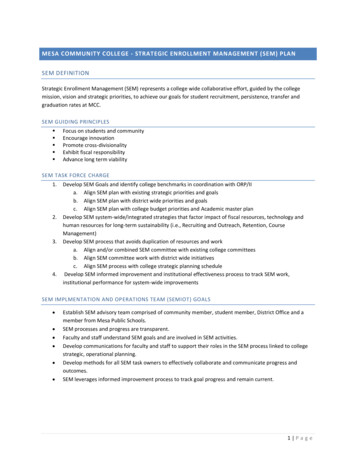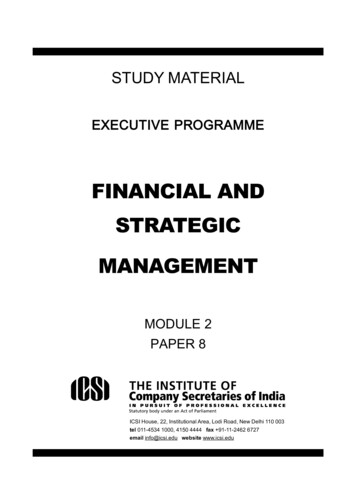
Transcription
STUDY MATERIALEXECUTIVE PROGRAMMEFINANCIAL ANDSTRATEGICMANAGEMENTMODULE 2PAPER 8ICSI House, 22, Institutional Area, Lodi Road, New Delhi 110 003tel 011-4534 1000, 4150 4444 fax 91-11-2462 6727email info@icsi.edu website www.icsi.edui
THE INSTITUTE OF COMPANY SECRETARIES OF INDIATIMING OF HEADQUARTERSMonday to FridayOffice Timings – 9.00 A.M. to 5.30 P.M.Public Dealing TimingsWithout financial transactions – 9.30 A.M. to 5.00 P.M.With financial transactions – 9.30 A.M. to 4.00 P.M.Phones41504444, fo@icsi.eduLaser Typesetting by AArushi Graphics, Prashant Vihar, New Delhi, andPrinted at MP Printersii
EXECUTIVE PROGRAMME – FINANCIAL ANDSTRATEGIC MANAGEMENTThe company secretaries by virtue of their expertise in the corporate laws and procedure are in eminentlysuitable position to:(a) Present to the Board of Directors, the financial, legal and personnel aspects of modernisation, expansion,diversification of the existing projects of new projects;(b) Obtain the decision from the Board; and(c) Interact effectively with the financial institutions in the process of procuring the finance.The legal aspects of finance are becoming increasingly important and a Company Secretary is expected tosuccessfully and effectively handle, amongst other things, important aspects such as management of publicissues, syndication of loans, obtaining project approvals, raising of finance through public deposits and debenturesor bonds etc. All these essentials require expert knowledge of diverse and complex procedures involved. Realisingthat the services of a Company Secretary could be of immense use in this important area, it was thoughtnecessary to include this paper with a view to equip the students with the requisite fundamentals of the Financialand Strategic Management.It has been the endeavour to provide a blend of theoretical concepts and practical orientation. Topics, such as,raising finance from financial institutions, dividend policies, etc. requiring legal expertise and procedural knowledgehave been written. Topics such as, project appraisal, financial planning, portfolio management and securitiesanalysis, working capital management and capital budgeting decisions, strategic management, business policy;strategic analysis & planning have been written keeping in view the financial and strategic management principlesand the practical utility. Ample number of practical problems and case studies have been added to aid thestudent in their learning process.Strategy is a broad concept that covers a multitude of different issues, concepts and methods. Strategy requiresa significant amount of work to understand and even the experts often find themselves searching for new waysto research and think about the topic. For managers and leaders, strategy is at the centre of the effort to createvalue for customers to respond to competitive challenges and to build strong organizations. All this leads tomake optimum utilization of organization’s material and human resources in order to achieve better financialperformance, improved qualitative decisions, employee motivation, minimum resistance to change, etc. by usingvarious theories, models and management techniques. An organization always operates in the environment ofrisk and uncertainty which is the result of operation of multiple forces i.e. economic, technological, legal, political,social and global. Strategic management helps the organization to develop set of decisions and actions resultingin formulation and implementation of strategies designed to achieve the objectives of an organization in a givenframe work.Though efforts have been made to provide a self-contained study material yet it may require regularsupplementation as the subject is of a dynamic and fast changing nature. Students are advised to update theirknowledge continuously by reading economic dailies, financial magazines and journal and other relevant literatureincluding reference and suggested readings on the subject. Students are expected to learn the art of applyingthe principles of financial management and strategic management to real business situations and for this casestudies in these area would prove to be of immense use.Although care has been taken in publishing this study material, yet the possibility of errors, omissions and/ordiscrepancies cannot be ruled out. This publication is released with an understanding that the Institute shall notbe responsible for any errors, omissions and/or discrepancies or any action taken in that behalf.Should there be any discrepancy, error or omission noted in the study material, the Institute shall be obliged ifthe same are brought to its notice for issue of corrigendum in the Student Company Secretary e-bulletin. In theevent of any doubt, students may write to the Directorate of Professional Development, Perspective Planningand Studies in the Institute for clarification at academics@icsi.edu.iii
EXECUTIVE PROGRAMMEModule 2Paper 8Financial and Strategic Management(Max Marks 100)Objective:Part I:To provide knowledge of practical aspects of financial management so as to develop skills intaking financial and investment decisions.Part II : To enable students to acquire multidimensional skills as to equip them to comprehend theprocess of strategy formulation.Part I : Financial Management (60 marks)Detailed Contents1. Nature and Scope of Financial Management: Nature, Scope and Objectives of Financial Management;Risk-Return and Value of the Firm; Objectives of the firm; Profit Maximisation vs. Wealth Maximisation;Emerging roles of Finance Managers.2. Capital Budgeting: Compounding and Discounting techniques – Concepts of Annuity and Perpetuity;Capital Budgeting Process; Techniques of Capital Budgeting- Discounted and Non- Discounted Cash FlowMethods; Capital Rationing; Risk Evaluation and Sensitivity Analysis.3. Capital Structure: Introduction- Meaning and Significance; Optimal Capital Structure; Determinants ofCapital Structure; Theories of Capital Structure; EBIT - EPS Analysis; EBITDA Analysis; Risk and Leverage;Effects of Leverage on Shareholders’ Returns.4. Sources of raising long-term finance and Cost of Capital: Sources, Meaning, Factors Affecting Cost ofCapital; Methods for Calculating cost of capital; Weighted Average Cost of Capital (WACC); Marginal Costof Capital.5. Project Finance : Project Planning - Preparation of Project Report, Project Appraisal under NormalInflationary and Deflationary Conditions; Project Appraisal by Financial Institutions - Lending Policies andAppraisal Norms by Financial Institutions and Banks; Project Review and Control; Social Cost and BenefitAnalysis of Project. Term loans from Financial institutions and Banks; Lease and Hire Purchase Finance;Venture Capital Funds; Private Equity; International Finance and Syndication of Loans, Deferred PaymentArrangements; Corporate Taxation and its Impact on Corporate Financing; Financing Cost Escalation.6. Dividend Policy: Introduction- Types; Determinants and Constraints of Dividend Policy; Forms of Dividend;Different Dividend Theories.iv
7. Working Capital : Meaning, Types, Determinants and Assessment of Working Capital Requirements,Negative Working Capital; Operating Cycle Concept and Applications of Quantitative Techniques;Management of Working Capital - Cash Receivables Inventories; Financing of Working Capital; BankingNorms and Macro Aspects; Factoring and Forfaiting.8. Security Analysis: Measuring of Systematic and Unsystematic Risk; Fundamental Analysis (Economic,Industry and Company); Technical Analysis and Efficient Market Hypothesis.9. Portfolio Management: Meaning, Objectives; Portfolio Theory -Traditional Approach; Markowitz PortfolioTheory; Modern Approach - CAPM Model; Economic Value Added; Sharpe Single & Multi Index Model;Risk Adjusted Measure of Performance.10. Introduction to Management: An Overview of functions of management.Part II : Strategic Management (40 Marks)11. Introduction to Strategic Management: An Overview- Meaning & Process; Strategic Leadership; Functionsand Importance for Professionals like Company Secretaries; Environmental Influences of BusinessCharacteristics and Components of Business Environment, Factors of Micro & Macro Environment ofBusiness; Competitive Environment and Porter’s Five Force Model.12. Business Policy and Formulation of Functional Strategy: Introduction to Business Policy; Frameworkof Strategic Management; Strategic Decision Model; Vision; Mission; Objectives and Goals; Strategic Levelsof the Organization; Formulation of Functional Strategy-Formulation of Financial; Marketing; Production;Human Resource and Logistics strategies.13. Strategic Analysis and Planning: Situational Analysis, Strategic Choices-SWOT and TOWS Analysis;PERT (Programme Evaluation Review Technique) and CPM (Critical Path Method); Portfolio analysisBoston Consulting Group (BCG) growth-share Matrix, Ansoff’s Product Growth Matrix, ADL Matrix andGeneral Electric (GE) Model; Strategic Planning; Strategic Alternatives-Glueck and Jauch and MichaelPorter’s Generic Strategies.14. Strategic Implementation and Control: Issues in Strategy Implementation; Various OrganizationalStructures and Strategy Implementation; Leadership and its forms ; Strategic Change and Control.15. Analysing Strategic Edge : Introduction to Business Process Reengineering; Concept of Benchmarking;Introduction to Total Quality Management and Six Sigma.v
LIST OF RECOMMENDED BOOKSMODULE 2PAPER 8 : FINANCIAL AND STRATEGIC MANAGEMENTThe students may refer to the given books for further knowledge and study of the subject :READINGS1. M Y Khan & P K Jain: Basic Financial Management ; McGraw Hill Education (India) Pvt Ltd.2. R. P. Rustagi: Financial Management – Theory, Concepts and Problems; TaxmannPublications (P) Ltd.3. Prasanna Chandra: Investment Analysis and Portfolio Management ; McGraw Hill Education(India) Pvt Ltd.4. I M Pandey: Financial Management; Vikas Publication House Ltd.5. Eugene F Brigham &Michael C Ehrhardt: Financial Management – Theory and Practice; Cengage Learning (India)Pvt Ltd.6. J Van Horne &John M. Wachowicz: Fundamentals of Financial Management ; Pearson Education Ltd.7. L.M. Prasad: Strategic Management; Sultan Chand & Sons, New Delhi8. Upendra Kachru: Strategic Management; McGraw Hill Education (India) Pvt Ltd.9. S N Chary: Production and Operations Management; McGraw Hill Education (India)Pvt. Ltd.vi
ARRANGEMENT OF STUDY LESSONSMODULE-2 PAPER 8FINANCIAL AND STRATEGIC MANAGEMENTSl. No.Chapter TitlePart I: Financial Management1.Nature, Significance and Scope of Financial Management2.Capital Budgeting3.Capital Structure4.Sources of raising Long term Finance and Cost of Capital5.Project Finance6.Dividend Policy7.Working Capital8.Security Analysis9.Portfolio Management10.Practical Problems and Case StudiesPart II: Strategic Management11.Introduction to Management12.Introduction to Strategic Management13.Business Policy and Formulation of Functional Strategy14.Strategic Analysis and Planning15.Strategic Implementation and Control16.Analysing Strategic Edgevii
CONTENTSPART I – FINANCIAL MANAGEMENTLESSON 1NATURE, SIGNIFICANCE AND SCOPE OF FINANCIAL MANAGEMENTMeaning of Finance2Meaning of Business Finance2Definition of Financial Management2Nature, Significance and Scope of Financial Management2Investment Decisions4Financing Decisions5Dividend Decisions5Decision Criteria6Objectives of Financial Management7(a) Profit Maximisation8(b) Shareholder Wealth Maximisation8Profit Maximisation versus Shareholder Wealth Maximisation9Economic Value-Added (EVA) – Means To Measure Shareholders Value Criteria11Value of Firm-Risk And Return12Liquidity13Profitability15Costing and Risk16Financial Distress and Insolvency18Financial Management as A Science or an Art19Functions of Financial Manager19LESSON ROUND-UP21SELF-TEST QUESTIONS21LESSON 2CAPITAL BUDGETINGTime Value of Money24Introduction24Why Rs. 1 received today is worth more than Rs. 1 received after a time period24viii
CONTENTSPageUse of Time Value of Money24Future Value of a lump sum25Present Value of a Lump Sum25Annuity26Perpetuity27Sinking Fund29Net Present Value29Capital budgeting30Definitions30Introduction30Capital Budgeting- Planning and Control of Capital Expenses30Need For Capital Investment31Investment Decisions – Management Perspective32Importance of Capital Budgeting32Factors Influencing Investment Decision33Rationale of Capital Budgeting Decisions34Kinds of Capital Budgeting Decisions34Planning of Capital Expenditure35Capital Expenditure Control35Capital Budgeting Process36Investment Criteria38Capital Budgeting Techniques39Traditional or Non- Discounted Cash Flow Techniques391. The Payback Period Method402. The Average Accounting Rate of Return (ARR) Method42Discounted Cash Flow (DCF) Method43A. Net Present Value Method (NPV)44B. Internal Rate of Return (IRR)45C. Profitability Index (PI) Method49Comparison of Net Present Value and Internal Rate of Return Methods50Points of Differences50Points of Similarities50Choice of Methods52ix
CONTENTSPageLimits on Investment52Capital Rationing53Introduction53Risk Evaluation and Sensitivity analysis53Standard Deviation and Coefficient of Variation54Risk Adjusted Discount Rate (RADR) Method54Certainty Equivalent Approach (CE Approach)55Decision Tree Analysis55Sensitivity Analysis in Capital Budgeting57Simulation for Risk Evaluation57Capital Budgeting Techniques under Uncertainty58Some Case Studies65LESSON ROUND-UP80SELF-TEST QUESTIONS81LESSON 3CAPITAL STRUCTUREIntroduction, Definition and Significance of Capital Structure86Introduction86Definition of Capital Structure86Type of Capital Structure86Significance of Capital Structure87Capital Structure vis-a-vis Financial Structure87Planning and Designing of Capital Structure89Attributes of a Well Planned Capital Structure89Designing a Capital Structure89Optimal Capital Structure90Factors Influencing Capital Structure90Capital Structure and Valuation93Capital Structure Theories93Criticism of MM Hypothesis99MM Hypothesis with Corporate Taxes100Empirical evidence Against MM Hypothesis100x
CONTENTSPageEBIT - EPS Analysis100EBITDA Analysis (Earnings before Interest, Tax, Depreciation And Amortization),103Analysis with EBITDA103Limitations of EBITDA103Measures of Operating and Financial Leverage104Definition of Leverage104Types of Leverage104OPERATING LEVERAGE104Degree of Operating Leverage105Uses of Operating Leverage106Financial Leverage106Degree of Financial Leverage106Alternative Definition of Financial Leverage106Uses of Financial Leverage107Difference between Operating Leverage And Financial Leverage108Financial BEP109Indifference Point109Combined Leverage109Degree of Combined Leverage109Working Capital Leverage110Effects of Leverage on Shareholders’ Returns111Risk and Leverage112Relationship between Financial Risk and Financial Leverage115Some Case Studies115LESSON ROUND-UP118SELF-TEST QUESTIONS119LESSON 4SOURCES OF RAISING LONG TERM FINANCE AND COST OF CAPITALIntroduction122Features of Long-Term Finance122Long Term Finance – Its Meaning and Purpose122Factors Determining Long-Term Financial Requirements122xi
CONTENTSPageSources of Long Term Finance123Cost of Capital124Meaning of Cost of Capital124Definitions of the term Cost of Capital124Assumption of Cost of Capital125Importance of Cost of Capital125Factors Determining the Firm’s Cost of Capital125Controllable Factors Affecting Cost of Capital126Uncontrollable Factors Affecting the Cost of Capital127Measurement of Cost of Capital127Cost of Debt (Kd)127Cost of debt which are issued at Discount128Cost of Bond/Debentures redeemable after certain period128After tax cost of Redeemable debt128Cost of Preference Share Capital129(1) Cost of Irredeemable preference shares129(2) Cost of Redeemable preference shares130Cost of Equity Capital1311. CAPM model1312. Bond Yield Plus Risk Premium Approach1323. Dividend Growth Model Approach1324. Earnings-Price Ratio approach133Cost of Retained Earnings133Weighted Average Cost of Capital133Book Value vs. Market Value weights135Marginal Cost of Capital (MCC)135Cost of Capital and Its Implications in Budgeting Decisions136Implications in Budgeting Decisions137Some Case Study137LESSON ROUND-UP142SELF-TEST QUESTIONS144xii
CONTENTSPageLESSON 5PROJECT FINANCEIntroduction146What is Project Finance?146What is Project Planning?146Importance of the Project Plan146Preparation of Project Report149Format of Project Report150Project Appraisal under Normal Conditions152Project Appraisal under Inflationary Conditions152Project Appraisal under Deflationary Conditions153Project Appraisal by Financial Institutions1541. The Project1542. The Promoters: Capacity and competence1553. Viability Tests155A. Technical Aspects of Project Appraisal155B. The Financial Aspects of Project Appraisal155C. Economic Appraisal157D. Social/distributive Appraisal157E. Environmental Aspects157F. Organizational and Managerial Aspects158G. Commercial Aspects Including Marketing158Lending Policies and Appraisal Norms By Financial Institutions And Banks158Loan Policy1591. Credit Deposit (CD) Ratio1592. Targeted Portfolio Mix1593. Hurdle ratings1594. Pricing of loans1605. Collateral security1606. Compliance with RBI guidelines1607. Directed Lending stipulations160Capital adequacy160Lending Exposure Limits161xiii
CONTENTSPageExposure norms for Commercial banks in India161Lending Rates162Loan Documentation162Loan Agreement of Financial Institutions163Usual conditions in Loan Agreement163Project Review and Control168Social Cost and Benefit Analysis (SCBA) of Project171UNIDO Approach of Social Cost benefit Analysis172Little – Mireless (L-M) Approach172Difference between UNIDO and L-M Approach173Different Sources of Finance173Term Loans from Financial Institutions and Banks173Financial Leverage and Term Loan173Features of a Term Loan:174Lease Finance174Finance Lease174Operating Lease175Hire-Purchase175Venture Capital176Private Equity176Types of Private Equity177Structure of Private Equity177Characteristics of Private Equity177Deferred Payment Arrangements177International finance and syndication of loans178New International Instruments178Syndicated Euro Currency Loans178Main Objectives of Syndication (Borrowers’ point of view)179Lenders’ point of view179Corporate Taxation and the Impact On Corporate Financing179Financing Cost Escalation180LESSON ROUND UP180SELF TEST QUESTIONS181xiv
CONTENTSPageLESSON 6DIVIDEND POLICYIntroduction184Types of Dividend Policies184Determinants/Constraints of Dividend Policy185Types of Dividend/Form of Dividend186(1) Cash Dividend186(2) Stock Dividend187(3) Bond Dividend187(4) Property Dividend187Theories of Dividend187Relevance of Dividend187Walter’s Model187Criticism of Walter’s Model189Gordon’s Model190Dividend and Uncertainty: The Bird-In-Hand Argument193Dividend Irrelevance: Modigliani - Miller Model193LESSON ROUND-UP199SELF-TEST QUESTIONS200LESSON 7WORKING CAPITALMeaning of Working Capital -The Basic Concept204Significance of working capital205Importance of Adequate Working Capital205Optimum Working Capital205Types of Working Capital205Determinants of working capital207Investment and Financing of Working Capital209Investment of working capital209Approaches of working capital investment209Current Assets to Fixed Assets Ratio210Estimating Working Capital Needs211xv
CONTENTSPageCurrent Assets and Fixed Assets Financing211Operating or Working Capital Cycle: Concept and Application of Quantitative Techniques212Assessment of Working capital215Working capital requirement assessment216Negative Working Capital216Quantitative Techniques for Forecasting Working Capital Needs219Financing of Working Capital220Working Capital – A Policy Decision221Working Capital Leverage222Ways to Improve Working Capital Position222Control of Working Capital224Banking Norms and Macro Aspect of Working Capital Management224Different Committee of RBI for working capital management2261. Daheja Study Group2262. Tandon Committee2273. Chore Committee2284. Marathe Committee2295. Chakraborty Committee2296. Kannan Committee229Other Issues Involved in the Management of Working Capital230Cash Management234Motives for holding cash234Level of cash holding235Components of cash and bank balances237William J. Baumal Model for Optimal Cash Balance Management237Strategy for effective cash management238Inventory Management239Benefits versus Costs240Extent and Quantum of Inventory Management240Strategy for Inventory Management240How cost of inventory can be lowered:241Managing the Inventory Level241Receivables Management246xvi
CONTENTSPageFactors Determining Credit Policy248Evaluation of Credit Policies (Format)249Control of Bad debts252Factoring Services252Definition and functions – Factoring Services252Factoring vs. Accounts Receivable Loans252Factoring vs. Bill Discounting253Mechanics of Factoring253Other Techniques for Control of Working Capital255Case Studies256LESSON ROUND-UP262SELF-TEST QUESTIONS263LESSON 8SECURITY ANALYSISIntroduction266What Are Securities266Investment266Investment vs. Speculation267Investment vs. Gambling267Risk and Its Types268Systematic Risk268Unsystematic Risk269Return of the Security270Measuring Return270Approaches to Valuation of Security271Case Study273Fundamental Approach to Valuation274Analysis of the economy277Industry Level Analysis277Company Analysis277Technical Analysis278Dow Jones Theory278xvii
CONTENTSPagePrimary Trends278Graph of Bullish Phase279Graph of a Bearish Phase279Secondary Trends280Minor Trend280Tools of Technical Analysis2801. Technical Charts280Line Chart280Bar Chart281Candlestick Charts282Point and Figure Charts282Patterns created by charts283Limitations of charts2852. Technical indicators286(a) Advance-Decline Ratio286(b) Market Breadth Index286(c) Moving Averages286Alternative Approaches to Valuation2861. Random walk theory2862. Efficient – Market Theory287LESSON ROUND-UP288SELF-TEST QUESTIONS289LESSON 9PORTFOLIO MANAGEMENTPortfolio Management292Portfolio Analysis292Risk in investment situation293Coefficient of Correlation294Calculation of Portfolio Risk295Markowitz Model297Simple Markowitz Portfolio Optimization298The Risk Penalty298xviii
CONTENTSPageStandard Deviation299Limitation of Markowitz Model299Capital Asset Pricing Model300Security Market Line303Arbitrage Pricing Theory305Sharpe Single and Multi Index Models306Sharpe Index Model306Single-Index Model306Multi-Index Model307Simple Sharpe Portfolio Optimization307Risk Adjusted Measure of Performance308Return (rx)309Risk-Free Rate of Return (rf)309Standard Deviation [Std Dev(x)]309Using the Sharpe Ratio309Economic Value Added310Case Studies311LESSON ROUND-UP315SELF-TEST QUESTIONS316LESSON 10PRACTICAL QUESTIONS AND CASE STUDIESPractical questions and case studies319MODEL TEST PAPER417xix
Pagexx
Lesson 1Nature, Significance and Scope of Financial ManagementLesson 1Nature, Significance and Scope ofFinancial ManagementLESSON OUTLINELEARNING OBJECTIVES– IntroductionFinancial management means the managementof finance of a business or an organization in orderto achieve the financial objectives. In anorganization the key objectives of financialmanagement is to create wealth for business,generate cash and gain maximum profits fromthe investments of the business considering therisks involved.– Nature, Scope and Objectives of FinancialManagement– Risk-Return and Value of the Firm– Objective of the Firm : Profit MaximisationVs. Wealth MaximisationGood financial management is very important foran organisation. It brings economic growth anddevelopment through investments, financing, anddividend and risk management decision which helpcompanies to undertake better projects. Lack offinancial management in business will lead tolosses and closure of business.– Emerging role of Finance Managers– LESSON ROUND UP– SELF TEST QUESTIONSThe object of the study is to enable the studentsunderstand –– Nature, Significance, and Scope ofFinancial Management– Financial Management Decisions Investment, Financial and Dividend– Decision Making Process– Objective of Financial Management– Economic Value Added – real growth of theorganization– Liquidity and Profitability– Financial Distress and Insolvency– Role and Function of Finance ManagersIf you want to rear financial blessings, you have to sow financially.Joel OsteenThoughtful financial planning can easily take a backseat to daily life.Suze Orman11
2 EP-F&SMMEANING OF FINANCEFinance may be defined as an art or a science of managing money. It includes financial service and financialinstruments. Finance is also referred as the provision of money at the time when it is needed. Finance function isthe procurement of funds and their effective utilization in business concerns.Webster’s Ninth New Collegiate Dictionary defines finance as ‘the Science on study of the management of funds’and the management of fund as the system that includes the circulation of money, the granting of credit, themaking of investments, and the provision of banking facilities.MEANING OF BUSINESS FINANCEAccording to the Wheeler, “Business finance is that business activity which concerns with the acquisition andconversion of capital funds in meeting financial needs and overall objectives of a business enterprise”. According tothe Guthumann and Dougall, “Business finance can broadly be defined as the activity concerned with planning,raising, controlling, administering of the funds used in the business”.In the words of Parhter and Wert, “Business finance deals primarily with raising, administering and disbursingfunds by privately owned business units operating in nonfinancial fields of industry”.Corporate finance is concerned with budgeting, financial forecasting, cash management, credit administration,investment analysis and fund procurement of the business needs to adopt modern technology and applicationsuitable to the dynamic global environment.DEFINITION OF FINANCIAL MANAGEMENTFinancial management is an integral part of overall management. It is concerned with the duties of the financialmanagers in the business firm. The term financial management has been defined by different experts as under :“It is concerned with the efficient use of an important economic resource namely, capital funds”. – SolomonFinancial management “as an application of general managerial principles to the area of financial decision-making.– Howard and UptonFinancial management “is an area of financial decision-making, harmonizing individual motives and enterprisegoals”. – Weston and BrighamFinancial management “is the operational activity of a business that is responsible for obtaining and effectivelyutilizing the funds necessary for efficient operations. – Joseph and MassieThus, financial management is broadly concerned with raising of funds, creating value to the assets of the businessenterprise by efficient allocation of funds. It is the study of integration of the flow of funds in the most optimal mannerto maximize the returns of a firm by taking proper decisions in utilizing the funds. In other words, raising of fundsshould involve minimum cost and to bring maximum retruns.NATURE, SIGNIFICANCE AND SCOPE OF FINANCIAL MANAGEMENTIn modern times, we cannot imagine a world without the use of money. In fact, money is the life-blood of businessin the present day world becasue all our economic activities are carried out through the use of money. For carryingon business, we need resources which are pooled in terms of money. It is used for obtaining physical and materialresources for carrying out productive activities and business operations which affect sales and pay compensationto suppliers of resources, physical as well as monetary. Hence financial management is considered as an organicfunction of a business and has rightly become an important one.A group of experts defines Financial Management as simply the task of providing funds needed by the business or
Lesson 1Nature, Significance and Scope of Financial Management3enterprise on terms that are most favourable in the light of its objectives. The approach, thus, is concerned almostexclusively with the procurement of funds and could be widened to include instruments, institutions and practicesthrough which to raise funds. It also covers the legal and accounting relationship between a company and itssources of funds. Financial Management is certainly broader than procurement of funds and there are other functionsand decisions too.Other set of experts assume that finance is concerned with cash. Since every business transaction involves cashdirectly or indirectly, finance may be assumed to be concerned with everything that takes place in the conduct of abusiness. Obviously, it is too broad.The third set of people whose point of view has been widely accepted considers Financial Management as procurementof funds and their effective utilisations in the business; though there are other organisations like schools, associations,government agencies etc., where funds are procured and used. So, Financial Management has not only to see thatfunds can be raised for installing plant and machinery at a cost; but it has also to see that additional profitsadequately compensate for the costs and risks borne by the business while setting up the project.Thus, from the point of view of a corporate unit, financial management is related not only to ‘fund-raising’ butencompasses wider perspective of managing the finances for the company efficiently. In the developed state of acapital market, raising funds is not a problem; the real problem is to put the capital resources to efficient usethrough effective financial planning, financial organisation and financial control and to deal with tasks like ensuringthe availability of funds, allocating them for different uses, managing them, investing funds, controlling costs,forecast
analysis, working capital management and capital budgeting decisions, strategic management, business policy; strategic analysis & planning have been written keeping in view the financial and strategic management principles . LIST OF RECOMMENDED BOOKS




